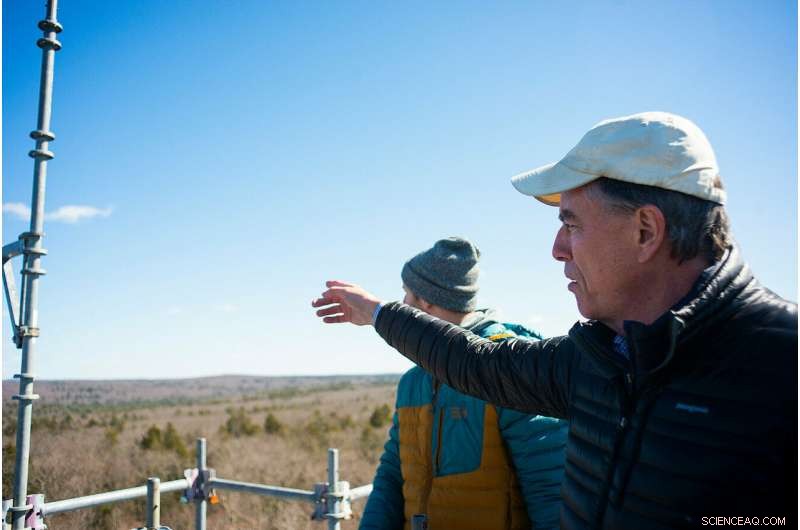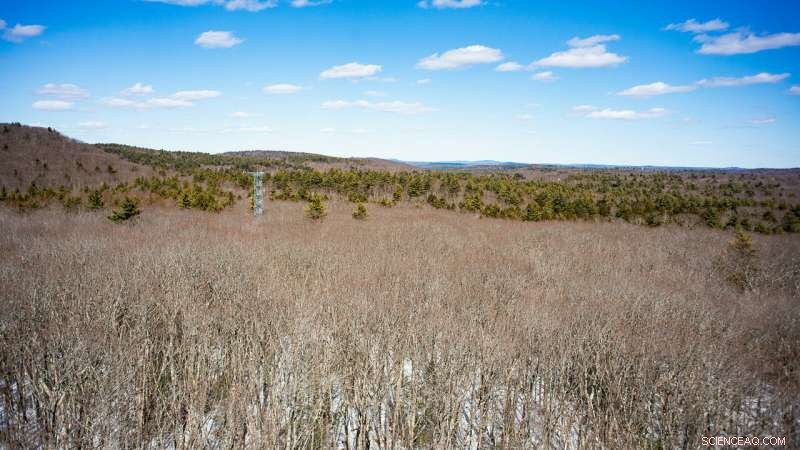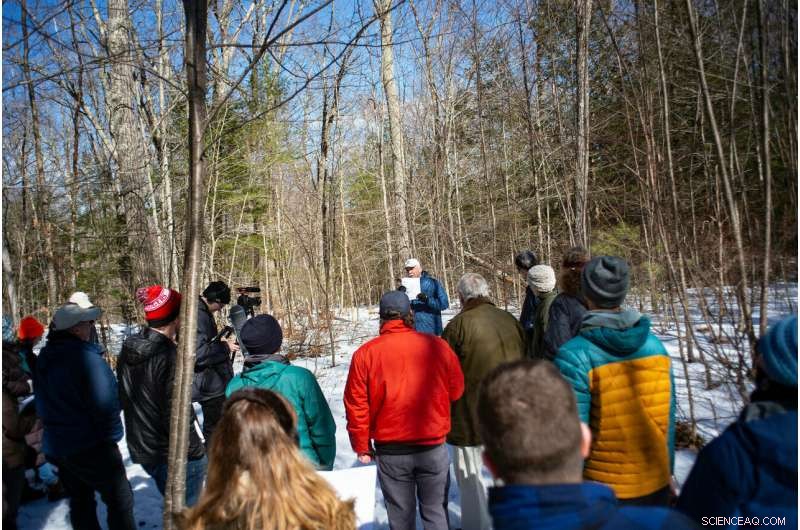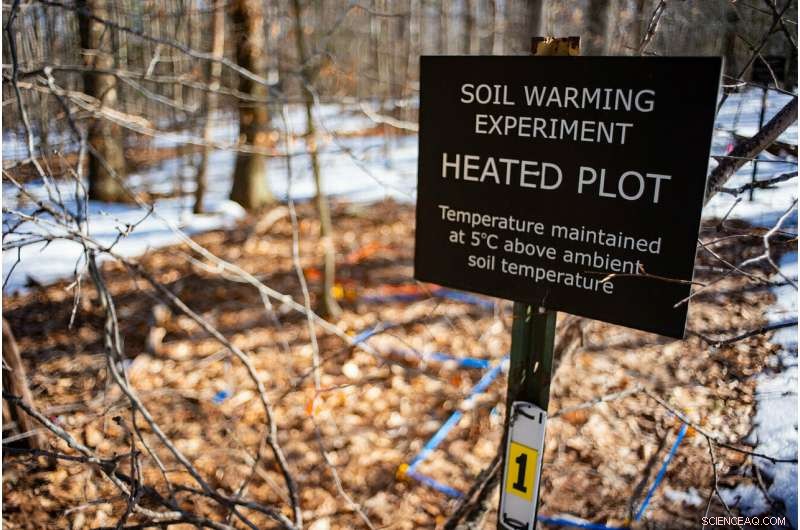
El director de Harvard Forest, David Foster, examina el paisaje desde lo alto de una torre de recolección de datos. Crédito:Kai-Jae Wang / Personal de Harvard
Hace casi 30 años, Los científicos de Harvard Forest comenzaron una experimento de larga duración en un terreno forestal de 2 acres utilizando un cable de acero largo, un cabrestante, y un vehículo maderero de servicio pesado llamado skidder.
Uno a uno, arrastraron el cable a 279 árboles seleccionados, lo colocó en lo alto del maletero, y luego comunicó por radio al tipo del skidder, estacionado fuera del tramo para evitar perturbar el suelo del bosque, para accionar el cabrestante. Y, uno a uno, los árboles cayeron.
Cuando terminaron, se habían aproximado al daño causado en Nueva Inglaterra por el Gran Huracán de 1938, creando un huracán experimental que afectó al 50 por ciento de los grandes árboles del dosel, abrió el sotobosque a nueva luz, puso en marcha un proceso de recuperación de décadas, y creó un paisaje de pesadilla de troncos caídos y ramas entrecruzadas más fáciles de atravesar por un experto en parkour que por los científicos encargados de registrar regularmente los cambios por venir.
Para marzo de 2019, la pesadilla se había calmado en gran medida. El suelo del bosque todavía estaba sembrado de troncos en descomposición, pero su lento regreso al suelo había avanzado lo suficiente como para que unas dos docenas de científicos y visitantes los atravesaran fácilmente en la parcela experimental cubierta de nieve. en el Tracto de Investigación Tom Swamp de Harvard Forest en Petersham, Massachusetts.
A su alrededor había árboles que, mientras más joven y delgado que los que reemplazaron, Hacía mucho tiempo que había cerrado las brechas en el dosel del bosque. Eran similares en composición a los anteriores a la tormenta, una sorpresa para los investigadores que esperan que se establezcan más especies pioneras. También fue notable lo poco llamativo que se veía el tratado. Era como muchos otros bosques caducifolios de Nueva Inglaterra, Desnuda y esperando la salida de las hojas de la primavera en una fría mañana de finales de invierno.
De hecho, esa cotidianeidad, una expresión de la estabilidad del ecosistema forestal de Nueva Inglaterra, incluso después de una calamidad única en un siglo, fue otra lección clave, junto con el hallazgo de que es mejor dejar que los bosques manejados como ambientes naturales se recuperen en lugar de ser ayudados por la "tala de salvamento" generalizada después de la tormenta de 1938 y aún común después de las explosiones, incendios e infestaciones de insectos que matan árboles en la actualidad.
Los científicos, provenientes de Harvard Forest e instituciones asociadas, reunidos esa mañana para reflexionar sobre la realización del experimento, Descubrimientos importantes, y la importancia de dicha investigación, que requiere un paciente, compromiso a largo plazo de las fuentes de financiación, de instituciones anfitrionas como Harvard Forest, y de los propios científicos, una vista cada vez más rara en un impaciente, resultados-ahora mundo.
Dirigiéndose a la asamblea esa mañana, El director de Harvard Forest, David Foster, dijo que el experimento del huracán fue importante no solo por la ciencia que permitió, pero también porque fue uno de los primeros y más llamativos después de la designación de Harvard Forest como un sitio de Investigación Ecológica a Largo Plazo (LTER) por la National Science Foundation en 1988.
Esa designación, renovada a intervalos de seis años, ha proporcionado una base de apoyo financiero, alrededor de $ 1 millón al año, para trabajos como el huracán experimental, y apalanca entre cinco y diez veces más fondos de otras agencias. Los proyectos LTER también son un punto focal para programas educativos en el bosque, incluidos los programas de K 12 y de nivel universitario. Miles de estudiantes de Harvard han visitado durante excursiones, trabajó en los sitios durante el programa de investigación de verano, y estudió sus hallazgos en el seminario de primer año de Foster sobre biología del cambio global.
El 18 y 19 de marzo Harvard Forest organizó un evento de dos días para conmemorar el 30 aniversario de su designación LTER. El primer día se dedicó a las visitas al sitio y el segundo a un simposio científico de un día de duración. con presentaciones detalladas de resultados hasta el momento a 125 asistentes. Hoy dia, Harvard Forest es uno de los 28 sitios LTER en todo el país, parte de una red que puede ser poco conocida por el público pero que los ecologistas veneran.
"Estos son lugares históricos para los ecologistas, "dijo Jonathan Thompson, ecologista senior de Harvard Forest, quien recientemente reemplazó a Foster como investigador principal de la subvención LTER del bosque. "No hay nada como ellos".
Después de ver la purga del huracán, científicos cargados en camionetas que se dirigían a otros experimentos a lo largo de las estrechas pistas de tierra que cruzan el 4, 000 acres de bosque. Una parada fue un grupo de altísimos árboles de hoja perenne, abetos supervisados por el ecologista senior David Orwig. Cientos de años y nunca registrados, Sin embargo, los días de los abetos están contados debido al asalto del invasor adelgido lanudo, cuya penetración tan al norte ha sido facilitada por los inviernos siempre cálidos de la región.
El grupo visitó el Sitio de Monitoreo Ambiental, donde se construyó la primera torre de investigación del mundo para medir la entrada y salida de gases a medida que respira el bosque. Investigación en la torre, iniciado por Steven Wofsy, Profesor Abbott Lawrence Rotch de Harvard de Ciencias Atmosféricas y Ambientales, y ahora supervisado por el investigador principal en química atmosférica J. William Munger, demostró que la recuperación de bosques como el de Nueva Inglaterra, talados en la época colonial, está ayudando a combatir el cambio climático al bloquear el carbono atmosférico en su madera a medida que los árboles crecen más gruesos y se elevan más.
El día terminó en un tablero de ajedrez de color marrón en el suelo del bosque nevado. Las parcelas sin nieve son el sello distintivo de un experimento de larga duración sobre el calentamiento del suelo. Usando cables calentados enterrados bajo tierra, El esfuerzo de casi 30 años busca comprender cómo los microbios del suelo y la respiración de las raíces de los árboles podrían responder a un mundo que se calienta.
Mantenido a 5 grados Celsius por encima del suelo circundante para reflejar el extremo superior de las estimaciones de calentamiento para fines de siglo, las parcelas han demostrado que los microbios y las raíces calentados se aceleran, aumentando rápidamente la cantidad de carbono liberado que se había encerrado en el suelo. Después de alcanzar un pico, las emisiones disminuyeron, estabilizado durante varios años, y luego, en otra sorpresa experimental más, se elevó a un segundo pico.
"Pensamos que tenemos un fenómeno de tres fases y hemos seguido haciendo mediciones, "dijo Jerry Melillo, distinguido científico del Laboratorio de Biología Marina de la Universidad de Chicago e investigador principal del bosque. "Ahora estamos en un segundo período de inactividad. En otros 20 o 30 años probablemente nos acerquemos a una respuesta".
Melillo dijo que la financiación de LTER era fundamental para el experimento, primero porque proporcionó un importante dinero fundamental que se incrementó con fondos de otras fuentes como el Departamento de Energía de EE. UU. Luego, cuando el interés disminuyó después de que disminuyó el primer pico de emisiones de carbono, la financiación de LTER mantuvo el experimento en marcha. Sin ello, Melillo dijo, la segunda explosión de emisiones de carbono, y la mejor comprensión de los efectos del calentamiento en los suelos forestales, habrían pasado desapercibidos.
LTER y un 'experimento característico'

Crédito:Kai-Jae Wang / Personal de Harvard
Melillo, who has conducted research at Harvard Forest for 40 years, played an important role in getting the initial LTER experiments up and running, Dijo Foster. Not long after the LTER designation, Melillo counseled that the forest needed something exciting to help it stand out.
"'What we need is a signature experiment, '" Foster recalled Melillo saying. "'We need something that they'll talk about at NSF, that'll be unlike something that anybody else has done.'
"I said, 'Jerry, what is that?' Y él dijo, 'I don't know, but we gotta have it.'"
Foster eventually seized on replicating one of the most devastating forces that mold the New England forest landscape:major hurricanes that blast ashore every 100 to 150 years. But how to do it? He rejected the idea of bulldozing trees because it would tear up the forest floor and disrupt the invisible but nonetheless critical cycling of nutrients and gases between the floor and the atmosphere.
When Foster suggested winching trees down instead, the idea was ridiculed as unworkable by a visiting scientist:The roots were far too strong. Foster chewed over the problem until he mentioned it to John Wisnewski, a Harvard Forest staffer with experience logging.
"'I'd just pull them over, '" Foster recalled Wisnewski saying. "'We do it all the time.'"
Wisnewski, today Harvard Forest's woods crew supervisor, told Foster that loggers need a flat area to stage removal of logs from the forest. So instead of cutting trees, which would leave stumps behind, they simply pull them down with a winch and cable, lop off the trunks, and pile the roots to one side.
An experimental path cleared, Foster turned to the forest's archive to plan the simulated storm In 1938, graduate student Willett Rowland recorded the Great Hurricane's damage at the forest, showing that about half of the large trees came down and that some species, such as white pine, were more susceptible to wind damage.
With that knowledge in hand, Foster laid out an east-west plot 50 meters by 160 meters in the Tom Swamp tract and marked the trees to come down. Preparations complete, they drove in the skidder and hauled the cable into the forest, pulling down tree after tree, all oriented so their crowns pointed northwest, as if felled by a hurricane's prevailing winds.

Tim Sipe (center, facing camera) speaks as part of a series of Harvard Forest events marking its 30th anniversary as a Long Term Ecological Research site. Credit:Kai-Jae Wang/Harvard Staff
Most trees came right over, Foster said, but some broke and were left to regrow as they were. Only one tree—a large old oak—resisted the skidder's tow.
"We decided that, bien, in a hurricane that tree wouldn't have fallen, " Foster said. "We went and found one of equal size downslope and pulled it over."
Then began the lengthy task of monitoring. An early revelation was the stability of key indicators like soil temperature, overall productivity, and carbon dioxide and nitrogen gas cycling among the trees, la tierra, y el ambiente.
Another was that the trees didn't die right away. Ninety percent of trees damaged by the winch leafed out regardless, photosynthesizing, drawing water from the earth, and contributing to the forest ecosystem even though they were flat on the ground. As they slowly died, the understory took over. Saplings that had been awaiting their chance shot upward, sprouts grew from the fallen trees' roots, and newly seeded trees got started. Lost production—measured in the amount of leaf litter each fall—recovered in just six years.
"Despite the fact that this looked like a destroyed forest, because it was physically altered in such a major way, it was functioning as an absolutely intact ecosystem, " Foster said.
In trying to understand the forest's unexpected stability, researchers realized that most experience with disturbed sites was at places subjected to the common practice of salvage logging, where fallen trees are cut and dragged out using soil-churning heavy equipment. En algunos casos, as after the 1938 hurricane, the piled debris left behind is burned.
"We're used to looking at sites that were subsequently disturbed after a major wind storm or ice storm by people going in and logging, " Foster said. "The 1938 hurricane was the biggest salvage logging exercise in U.S. history. And it pretty comprehensively turned the 1938 hurricane into one great big cutting operation.
"In almost every case you can think of, if your intent is to encourage the recovery of the forest and ecosystem function with minimal change … doing nothing becomes a viable alternative."
When Audrey Barker-Plotkin arrived at the site eight years after the pulldown, just walking around was a challenge. Today a senior researcher and the author of several studies on the site, she recalled having to weave through tangled branches and wrestle with wiry new growth that all seemed to be at "face level."

A sign marks a 20-year heated soil experiment. Credit:Kai-Jae Wang/Harvard Staff
"It was like walking through a jungle gym. The plot seems a lot smaller now that you can see through it, " Barker-Plotkin told the visiting scientists. "Just the changes I've seen in 20 years have been really remarkable. … [The site] was different every single year."
Another thing scientists didn't expect, Barker-Plotkin said, was the stability of the tract's species makeup. Researchers thought that more pioneer species like cherry and paper birch—usually fast-growing colonizers of disturbed sites—would take hold. But the stability of even the damaged ecosystem didn't provide much of an opening. While those species did appear in disturbed soil around upturned roots, that was less than 10 percent of the forest floor. Invasive species, another threat at disturbed sites, were also absent, ella dijo.
Hoy dia, ella dijo, the experimental plot has largely recovered structurally, but is still struggling to catch up with the surrounding forest's growth. Tree volume has reached about 80 percent of what it was before the pulldown, but measurements of the nearby control plot show that the surrounding forest has grown 25 percent over the intervening decades as part of New England forests' continued recovery from Colonial-era clear-cutting.
New leaders and a landscape full of questions
Like the long-term processes they measure, the hurricane pulldown and other experiments continue to produce data even as their original investigators' careers come to a close. A smooth transition to new leadership will be essential in maintaining both research continuity and excellence, Dijo Foster. At several sites the group visited, experimental founders handed off presentations to younger researchers, as Foster did to Barker-Plotkin at the hurricane site and Melillo did to University of New Hampshire Professor Serita Frey, a soil microbe expert, at the soil warming experiments.
LTER's new principal investigator, Thompson, spoke of the importance of ensuring the continuity of key long-term experiments even as researchers move on from work that has run its scientific course.
"En algunas formas, the experiments they set up in the '80s just look so prescient now, " él dijo.
An important question still to be explored is how long recovering forests will keep absorbing carbon, Thompson added. That answer has potentially crucial implications for climate change, since global forests absorb roughly 20 percent of the excess carbon humans emit.
Parte del problema Thompson said, is that though remnant old-growth patches exist, they may not be good models for understanding forests regrowing on former farmland, since they're typically in poor growing locations, which is why they weren't cut in the first place.
"We know how much [carbon] is in the forests, " Thompson said, "but we don't know how much carbon can be in these forests."
Esta historia se publica por cortesía de Harvard Gazette, Periódico oficial de la Universidad de Harvard. Para noticias universitarias adicionales, visite Harvard.edu.